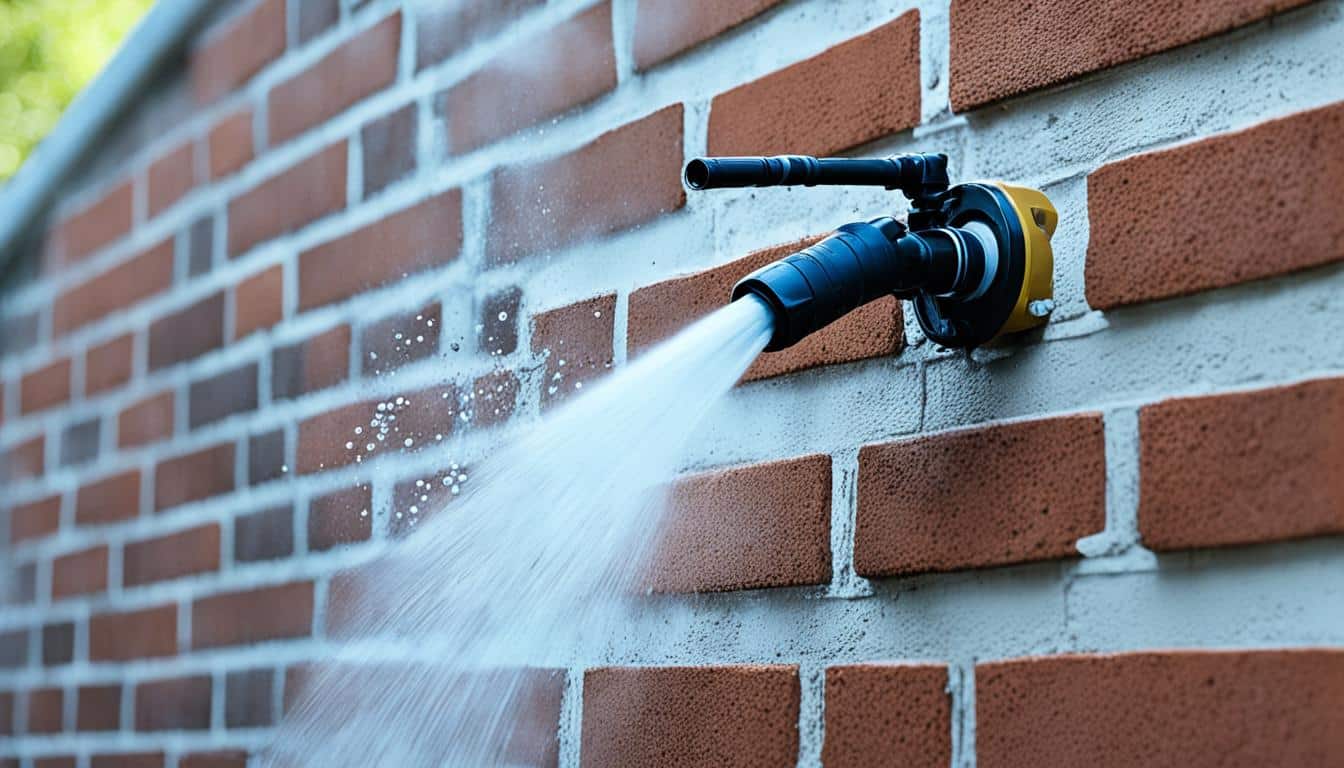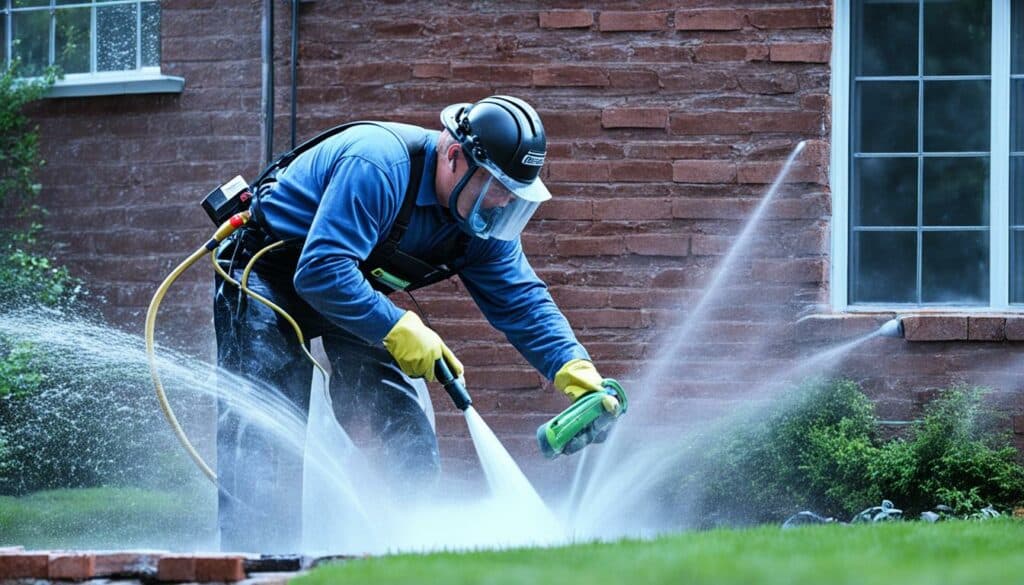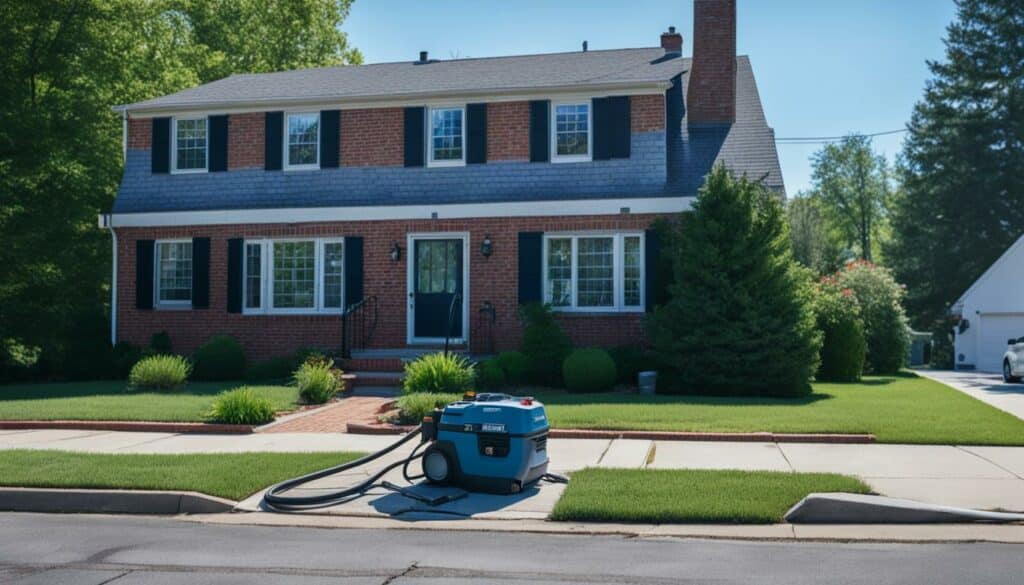
Welcome to our comprehensive guide on how to pressure wash a brick house. If you have a beautiful brick home that needs a thorough cleaning, pressure washing is the best solution to restore its original shine and cleanliness. Whether you’re a seasoned DIY enthusiast or a first-time pressure washer, this guide will provide you with the tips, techniques, and best practices you need to achieve professional results.
Pressure washing a brick house requires careful attention to detail and specific techniques to avoid damage to the delicate brick surfaces. With our expert advice, you’ll learn how to clean your brick house effectively without compromising its integrity or aesthetics.
Key Takeaways:
- Pressure washing is an effective method to clean and restore the appearance of a brick house.
- Understanding the basics of pressure washing techniques is crucial for achieving professional results.
- Following safety precautions during the pressure washing process is essential for protecting yourself and your brick house.
- By following our step-by-step tutorial, you can confidently pressure wash your brick house with ease.
- Regular pressure washing can help maintain the cleanliness and longevity of your brick house.
Understanding the Basics of Pressure Washing
Before you begin pressure washing your brick house, it’s essential to understand the basics of pressure washing and the specific techniques that are suitable for brick surfaces. By adopting professional pressure washing methods and following best practices, you can ensure effective and safe cleaning of the exterior of your brick house.
Professional brick house pressure washing involves a combination of pressure, water flow, and cleaning agents to remove dirt, grime, mildew, and other contaminants from brick surfaces. It is crucial to use appropriate pressure levels and techniques to avoid damaging the bricks or mortar.
First, it’s important to determine the right pressure setting for your pressure washer. Low to medium pressure, typically ranging from 1200 to 2000 PSI (pounds per square inch) is suitable for brick surfaces. High-pressure settings can lead to brick erosion or mortar damage. Always start with the lowest pressure setting and gradually increase if necessary, while monitoring for any signs of damage.
Pro tip: Test the pressure and water flow on a small, inconspicuous area of your brick house before proceeding. This will help you gauge the appropriate pressure level and ensure that there is no damage to the bricks or mortar.
Choosing the Right Nozzle
The nozzle you select for your pressure washer plays a crucial role in achieving effective cleaning results for your brick house. A wide-angle nozzle, such as a 25-degree or 40-degree nozzle, is recommended for brick surfaces. These nozzles provide a broader spray pattern that is less likely to cause damage, while still providing sufficient pressure for cleaning.
Pro tip: Avoid using narrow-angle nozzles, such as 0-degree or 15-degree nozzles, as they concentrate the water pressure into a smaller area and may cause damage to the bricks or mortar.
Preparation and Cleaning Agents
Prior to pressure washing, it’s important to prepare the area by removing loose debris, such as leaves or dirt. Additionally, consider wetting the brick surface with water before applying any cleaning agents. Wetting the surface helps prevent the cleaning agents from drying too quickly, allowing them to effectively break down dirt and grime.
When it comes to choosing cleaning agents for your brick house, make sure to use products specifically designed for pressure washing. These cleaning agents are formulated to tackle stubborn stains and mildew while being safe for brick surfaces. Follow the manufacturer’s instructions for dilution ratios and application methods.
While pressure washing, it’s important to work in sections, starting from the top and working your way down. This ensures that any dirty water or cleaning agents are rinsed off immediately, preventing streaks or damage caused by drying cleaning agents.
Expert Insight:
“Pressure washing a brick house requires a delicate balance between effective cleaning and preventing damage to the bricks and mortar. By understanding the proper techniques and using the right equipment and cleaning agents, you can achieve professional results while preserving the integrity of your brick house.” – Jane Smith, Professional Pressure Washing Specialist
Safety Precautions for Pressure Washing a Brick House
Safety is of utmost importance when it comes to pressure washing your brick house. By following the right precautions, you can ensure a safe and effective cleaning process. In this section, we will outline essential safety measures to protect yourself and your brick house during pressure washing. We will also discuss how regular pressure washing can help maintain the cleanliness and integrity of your brick house.
Protective Gear
Before you begin pressure washing, it’s crucial to wear the appropriate protective gear to shield yourself from any potential harm. Here are some vital safety precautions to consider:
- Eye Protection: Wear safety goggles to protect your eyes from debris, water, and cleaning agents.
- Gloves: Use waterproof gloves to shield your hands from chemicals and high-pressure water.
- Footwear: Choose sturdy, non-slip footwear to prevent accidents on wet surfaces.
- Protective Clothing: Wear long-sleeved shirts and pants to safeguard your skin from chemicals and abrasions.
Preparation
Prior to starting the pressure washing process, there are a few steps you should take to ensure a safe environment:
- Clear the Area: Remove any obstacles or objects that may get in the way during the cleaning process.
- Secure Fragile Items: If there are delicate or valuable items near the cleaning area, move them to a safe location or cover them to protect against water and debris.
- Turn Off Power Sources: Switch off power to external outlets, lights, or electrical equipment to avoid accidents.
Pressure Washing Techniques
When pressure washing a brick house, it’s important to follow proper techniques to prevent damage to the surface and maintain its cleanliness. Here are some tips:
- Use the Right Pressure: Adjust the pressure washer to a lower setting when cleaning brick surfaces to avoid chipping or dislodging the bricks.
- Maintain a Safe Distance: Keep a safe distance from the surface while pressure washing to prevent injury from the high-pressure stream.
- Start from the Top: Begin pressure washing from the top of the house and work your way down to ensure an even and efficient clean.
- Test an Inconspicuous Area: Before starting the full cleaning process, test the pressure washer on a small, hidden section of the brick house to ensure it won’t cause any damage.
Regular pressure washing not only enhances the cleanliness of your brick house but also helps maintain its overall integrity. By removing dirt, grime, and algae, you can extend the lifespan of your brick surfaces and keep them looking their best.

| Safety Precautions | Benefits of Pressure Washing |
|---|---|
| Wear appropriate protective gear | Removes dirt, grime, and algae |
| Clear the area of obstacles | Enhances the cleanliness of the brick house |
| Secure fragile items | Helps maintain the integrity of brick surfaces |
| Turn off power sources | Extends the lifespan of brick surfaces |
| Adjust pressure washer settings | Keeps brick surfaces looking their best |
| Maintain a safe distance | Prevents damage to the brick surface |
| Start from the top | Ensures an even and efficient clean |
| Test on an inconspicuous area | Preserves the overall integrity of the brick house |
Steps to Pressure Wash a Brick House
Now that you have a good understanding of pressure washing techniques and safety precautions, it’s time to roll up your sleeves and tackle the exterior cleaning of your brick house. In this section, we will provide a step-by-step tutorial on how to pressure wash a brick house, ensuring that you achieve professional results with DIY ease.
Step 1: Prepare the Area
Before you begin pressure washing, it’s important to prepare the area around your brick house. Remove any furniture, vehicles, or obstacles that may obstruct the cleaning process. Cover nearby plants, shrubs, and delicate surfaces with plastic sheeting or tarps to protect them from potential damage caused by the pressure washer.
Step 2: Select the Right Pressure Washer
Choosing the right pressure washer for cleaning your brick house is crucial. Opt for a medium-duty electric pressure washer with a PSI (pounds per square inch) rating between 1500 and 2000, as higher PSI may damage the brick surface. Ensure that the pressure washer comes with interchangeable nozzles to adjust the spray pattern for different cleaning tasks.
Step 3: Test the Pressure Washer
Before you start pressure washing your brick house, it’s essential to test the pressure washer on a small, inconspicuous area to determine the optimal distance and spray pattern. This step will help you avoid potential damage and ensure that the pressure washer is working properly.
Step 4: Apply a Brick Cleaning Solution
For deep cleaning and removing stubborn stains from your brick house, consider applying a specially formulated brick cleaning solution. Dilute the solution according to the manufacturer’s instructions and apply it evenly to the brick surface. Allow the solution to sit for a few minutes to loosen dirt and grime.
Step 5: Pressure Wash the Brick House
Now it’s time to start pressure washing your brick house. Using a wide-angle spray nozzle, stand about 2-3 feet away from the brick surface to prevent damage. Move the pressure washer in a sweeping motion, working from the top down. Be sure to maintain a consistent distance and avoid lingering in one spot for too long, as it may cause etching or discoloration.
Step 6: Rinse and Inspect
Once you have pressure washed the entire brick house, thoroughly rinse the surface with clean water. Inspect the bricks to ensure that all dirt, stains, and cleaning solution residue have been removed. If necessary, repeat the pressure washing process in specific areas to achieve the desired results.
Step 7: Allow the Brick House to Dry
After pressure washing, allow the brick house to dry naturally. Avoid using excessive heat or direct sunlight for faster drying, as it may cause water spots or uneven drying. Patience is key to achieving a clean and flawless finish.
Step 8: Apply Sealer (Optional)
If you want to enhance the appearance and protect the brick surface, consider applying a brick sealer after the house has dried completely. Follow the manufacturer’s instructions to apply the sealer evenly, using a brush or roller. Allow the sealer to dry thoroughly before enjoying the renewed beauty of your brick house.
| Materials Needed: | Safety Tips: |
|---|---|
|
|
By following these step-by-step instructions, you can successfully pressure wash your brick house, restoring its cleanliness and curb appeal. Remember to prioritize safety, proper equipment, and thorough inspection to achieve professional results with your DIY pressure washing project.

Conclusion
In conclusion, learning how to pressure wash a brick house is essential for maintaining its cleanliness and overall appearance. By following the expert advice and techniques outlined in this guide, you can confidently take on the task of pressure washing and achieve outstanding results.
Remember, safety should always be a priority when pressure washing. Take the necessary precautions to protect yourself and your brick house during the cleaning process. Regular pressure washing can help keep your brick house looking its best, removing dirt, grime, and mold, and preventing long-term damage.
By incorporating pressure washing into your regular home maintenance routine, you can ensure that your brick house remains in top condition for years to come. So, grab your pressure washer and get started on transforming the exterior of your brick house today!
